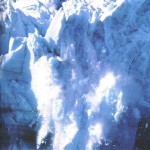 About a decade ago, Doctor R.J. Braithwaite wrote an article that appeared in Progress in Physical Geography.
About a decade ago, Doctor R.J. Braithwaite wrote an article that appeared in Progress in Physical Geography.
In that article, which was peer-reviewed, Doctor Braithwaite tells us how he analyzed 246 glaciers, sampled from both hemispheres and latitudes, between the years 1946 and 1995. This “mass balance analysis” he conducted found that “some glaciers were melting, while a nearly equal number were growing in size, and still others remained stable.” Doctor Braithwaite’s unequivocal conclusion:
“There is no obvious common or global trend of increasing glacier melt in recent years.”
“By some estimates, 160,000 glaciers exist on Earth. Only 63,000 have been inventoried, and only a few hundred have been studied in the detail described by Braithwaite” (“It Would Be Nice to Know More about Ice,” Jay Lehr).
On the basis of that logical fallacy known as the fallacy of insufficient evidence, all glacier fears are stopped cold right there.
But in fact that’s only the tip of the iceberg.
Keith Echelmeyer, a glaciologist at the University of Alaska’s Geophysical Institute, says this:
“To make a case that glaciers are retreating, and that the problem is global warming, is very hard to do… The physics are very complex. There is much more involved than just the climate response.”
Mr. Echelmeyer goes on to tell us that in Alaska there are large glaciers advancing in the very same areas where others are retreating.
Quoting Doctor Martin Beniston of the Institute of Geography at the University of Fribourg, Switzerland:
Numerous climatological details of mountains are overlooked by the climate models, which thus makes it difficult to estimate the exact response of glaciers to global warming, because glacier dynamics are influenced by numerous factors other than climate, even though temperature and cloudiness may be the dominant controlling factors. According to the size, exposure and altitude of glaciers, different response times can be expected for the same climatic forcing.
Of course, as Doctor Beniston intimates, the paramount thing to consider in any discussion of glacial melt is the sheer size of these suckers, which because of their size do not respond to heat and cold like the snow in your backyard. According to the excellent glacier program at Rice University, those response times run something like this:
Ice sheet: 100,000 to 10,000 years
Large valley glacier: 10,000 to 1,000 years
Small valley glacier: 1,000 to 100 years
Glaciers are influenced by a variety of local and regional natural phenomena that scientists do not fully comprehend. Besides temperature changes, glaciers also respond to changes in the amount and type of precipitation, changes in sea level and changes in ocean circulation patterns. As a result, glaciers do not necessarily advance during colder weather and retreat during warmer weather (John Carlisle, National Center for Public Policy).
Glaciers Are In World-Wide Retreat — read one New York Times headline recently.
Well, they were anyway, starting decades before industrialization (i.e. increased CO2 output). As IPCC AR4 reports:
Most mountain glaciers and ice caps have been shrinking, with the retreat probably having started about 1850 [NB: the end of the ‘little ice age’]. Although many Northern Hemisphere glaciers had a few years of near balance around 1970, this was followed by increased shrinkage.
Research published by the National Academy of Sciences indicates that the much-touted Peruvian glacier (on p. 53-53) disappeared a few thousand years ago.
There are, moreover, glaciers forming across the globe, in both hemispheres. Here’s a very partial list:
In Norway: Alfotbreen Glacier, Briksdalsbreen Glacier, Nigardsbreen Glacier, Hardangerjøkulen Glacier, Hansebreen Glacier, Jostefonn Glacier, Engabreen Glacier, Helm Glacier, Place Glacier. Indeed, a great number of Scandinavia’s glaciers are exploding.
In France, the Mount Blanc Glacier.
In Ecuador, Antizana 15 Alpha Glacier.
In Argentine, Perito Moreno Glacier, the largest in all of Patagonia, was recently observed to be advancing at about 6 feet per day.
Chile’s Pio XI Glacier, the largest in the southern hemisphere, is also growing.
In Switzerland, Silvretta Glacier.
In Kirghiztan, Abramov Glacier.
In Russian, Malli Glacier is growing and surging.
In New Zealand, as of 2003, all 48 glaciers in the Southern Alps were observed to have grown.
In the United States: Mount St. Helens, Mount Rainier, Mount Shuksan, Mount Shasta, Mount McKinley, Mount Hubbard, and Rocky Mountain National Park have all shown recent glacier growth.
“There is evidence that the McGinnis Glacier, a little-known tongue of ice in the central Alaska Range, has surged,” said assistant Professor of Physics Martin Truffer. He recently noticed the lower portion of the glacier was covered in cracks, crevasses, and pinnacles of ice – all telltale signs that the glacier has recently slid forward at higher than normal rates.
There’s also this article from the Associated Press, which I quote only in part:
Geologists exploring Colorado’s Rocky Mountain Park say that they discovered more than 100 additional glaciers here in a single summer, said Mark Verrengia.
Officials previously believed the park, which is 60 miles northwest of Denver, included 20 permanent ice and snow features, including six named glaciers. The new survey, conducted by geologist Jonathan Achuff, shows there are as many as 120 features.
“Comparisons with historical photos suggest that at least some of the glaciers are expanding,” say park officials. “Subtle climate changes may be helping the formation of glaciers or at least reducing their retreat.”
“We’re not running quite in sync with global warming here,” park spokeswoman Judy Visty said.
Not, of course, that it really matters much either way, since the entire climate change issue is predicated upon a stupendously fraudulent premise: a corrupt epistemology.
To say nothing of the fact that, as has been demonstrated repeatedly, the free market is far better equipped to deal with environmental issues than proposed socialist policies — for the simple reason that free markets generate astronomically more capital with which to deal with such issues.
The wealthier the country, the healthier the country.
